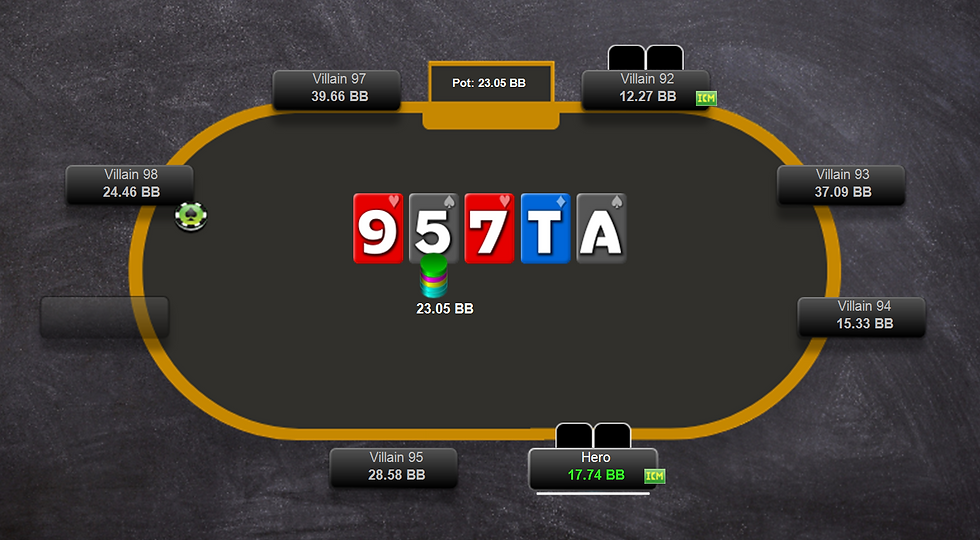OTB #035: How I Think About River Bets In Position - A 3-Step Framework
- Gareth James
- Mar 2, 2024
- 4 min read
Updated: Apr 10, 2025

You open from the Hijack and just the Big Blind calls. You're playing about 23bb effective against the Big Blind.
The BB checks on the 975fd flop, you c-bet 2.88bb into 5.41bb and the BB calls.
The BB checks on the Td turn, you bet 5.94bb into 11.17bb and the BB calls.
The river is the As and the BB checks again.
When you land on this river you should know:
Which hands you should bluff
Which hands you should value bet
Which hands you should check back
Today I want to show you how I think about river bets in position and show you a simple framework for approaching the biggest money street in poker.
Let's dive in...
Polarised vs condensed ranges
No range is truly polarised until the river.
If you choose to bet, you will have a polarised range of value bets and bluffs.
The Big Blind has a condensed range, which can include some strong hands, but is mainly made up of medium strength hands and bluff catchers.
When you land on the river and face a check, you should know whether you have a hand good enough to value bet, a hand that's good enough to showdown and win sometimes, or a hand that isn't good enough to value bet or win at showdown and might make a good candidate for a bluff.
This means you can group your range on the river into 3 buckets:
Value bets
Showdown value hands
Bluffs
As you can see in this diagram of your best hands (at the top) to your worst hands (at the bottom), there's a clear pattern. Pink = bet, Green = check
You want to value bet top pair and better and you want to bluff with King high and worse.
The hands in the middle just want to check. Although it's a bit more complicated as some underpairs and 2nd pairs can bet for thin value. And some low pairs want to bluff.
Value bets
The first step is working out what's the worst hand you can value bet. From there, you know you can pretty much always value bet anything better.
There are some rare exceptions where you might not bet top set when a flush is possible since you block a lot of top pair bluff catchers.
Hero can jam for value here with:
Sets (AA, 77, 55)
Two pair (AT, T9s, 97s)
Top pair (Ax)
Showdown value
The hands in the middle of your range will want to check.
That means hands that aren't good enough to value bet and are too good to bluff.
Hero should check back with these hands:
Underpairs (KK, QQ, JJ)
2nd pairs (Tx)
3rd pairs (98s)
Underpairs are somewhat indifferent, as are a little bit of Tx hands.
This is because when you jam these hands, the Big Blind is supposed to call hands like Tx, J9s, 94s, 93s and hands like Q9 and K9 are indifferent. If you believe the Big Blind will fold those hands, then you can't value jam as thinly and all those hands make much better check backs.
Remember that in order to value bet, you need enough worse hands to call.
If those worse hands don't exist in your opponent's calling range and you just get called by top pair and better here, then it doesn't make logical sense to jam underpairs or any Tx hands.
You don't get called by worse hands (so it's not a value bet) and you certainly can't get better hands to fold (so it's not a bluff).
Bluffs
Finally you will land on the river with hands that are not good enough to value bet or to showdown and you have to consider bluffing with them.
It's a common misconception that you need to bluff all hands in this category, although in this actual hand example that's exactly what's going on.
Hero should bluff here with:
Low pairs (88, 65s)
King high
Anything worse than King high
When you're bluffing, you first need to know that you can get a better hand to fold.
Then you want to block hands that can call and unblock hands that will fold.
If you jam 65s you block some strong hands that can call, like A5s and T5s, and you get better hands like better 5x, 7x and some 9x hands to fold.
This week's action tip: filter your database for river spots and put your range into the 3 different buckets: value, showdown and bluffs.
Summary
When you land on the river you should be able to put all the hands in your range into 3 buckets:
Value bets
Showdown value
Bluffs
Even though in this example the river decision was between jamming or checking, there will be other river spots where you can bet 1/2 pot or 90% pot instead.
You can apply the same principles, but recognise that the smaller you bet, the thinner you can bet for value. But also, you can't bluff as much.
The bigger you bet, the more polarised you can be.
That's it for this week.
See you next time.






Comments